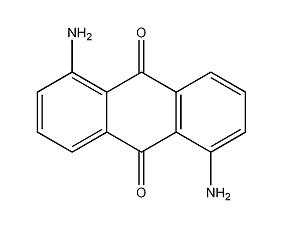
Structural formula
| Business number | 03LZ |
|---|---|
| Molecular formula | C14H10N2O2 |
| Molecular weight | 238.25 |
| label |
1,5-diamine enquinsulfonic acid, 1,5-diamino-9,10-anthraquinone, aromatic compounds |
Numbering system
CAS number:129-44-2
MDL number:MFCD00001226
EINECS number:204-947-2
RTECS number:CB6400000
BRN number:None
PubChem number:24862850
Physical property data
1. Properties: dark red needle crystals (in ethanol, acetic acid).
2. Melting point (decomposition, ℃): 308
3. Solubility: soluble in hot nitrobenzene, slightly soluble in ethanol, ether, benzene, acetone, and chloroform. The solution in concentrated sulfuric acid is almost colorless.
Toxicological data
1. Skin/eye irritation: Rabbit eye standard Drez eye dye test: 500mg/24H has a slight irritating effect on the eyes.
2. Acute toxicity: rat transperitoneal LD5O: 1300mg/kg
3. Mutagenicity: Salmonella gene mutation testing system: 500ug/plate
Ecological data
None yet
Molecular structure data
1. Molar refractive index: 67.14
2. Molar volume (cm3/mol): 163.6
3. Isotonic specific volume (90.2K ): 490.7
4. Surface tension (dyne/cm): 80.9
5. Polarizability (10-24cm3): 26.61
Compute chemical data
1. Reference value for hydrophobic parameter calculation (XlogP): 2.6
2. Number of hydrogen bond donors: 2
3. Number of hydrogen bond acceptors: 4
4. Number of rotatable chemical bonds: 0
5. Number of tautomers: 15
6. Topological molecule polar surface area 86.2
7. Number of heavy atoms: 18
8. Surface charge: 0
9. Complexity: 346
10. Number of isotope atoms: 0
11. Determine the number of atomic stereocenters: 0
12. Uncertain number of atomic stereocenters: 0
13. Determine the number of chemical bond stereocenters: 0
14. Number of uncertain chemical bond stereocenters: 0
15. Number of covalent bond units: 1
Properties and stability
Basic properties
Red-brown needle-like crystals. Melting point 319℃. Soluble in hot nitrobenzene, slightly soluble in ethanol, ether, benzene, chloroform and acetone, insoluble in water. Heating and sublimation.
Storage method
None yet
Synthesis method
The nitrification reduction method is mainly used. Anthraquinone is used as raw material. It is nitrated with mixed acid in concentrated sulfuric acid to obtain 1,5-dinitroanthraquinone and 1,8-diaminanthraquinone. After filtering and washing, they are then reduced with sodium sulfide, and then Obtained by filtering, washing and drying.
Purpose
Dye intermediates. Mainly used to prepare anthraquinone reduction dyes reduction yellow 3RT, reduction orange 3G, reduction orange 3C, reduction gray 3Y, and other anthraquinone dyes such as��Lan et al.

 微信扫一扫打赏
微信扫一扫打赏

